着装礼仪及服饰搭配(英文)课件
- 格式:pdf
- 大小:3.29 MB
- 文档页数:22
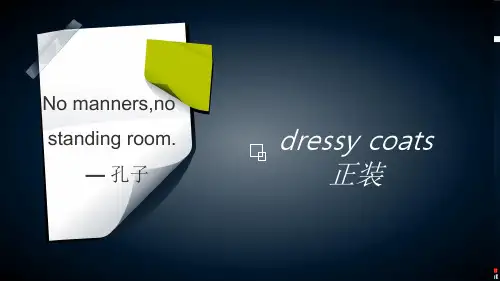
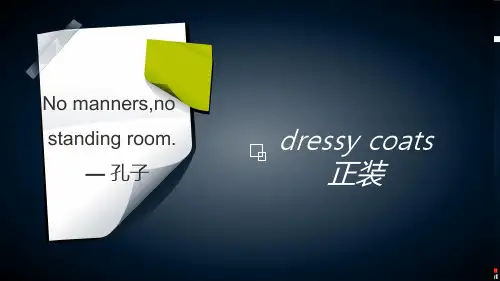
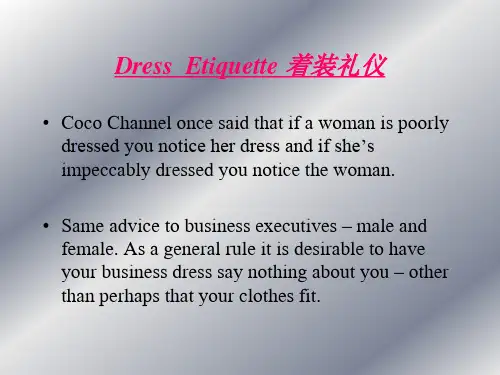
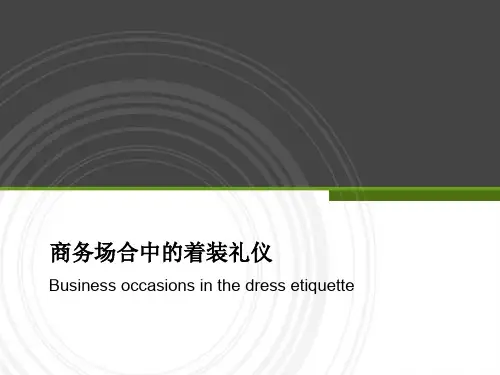
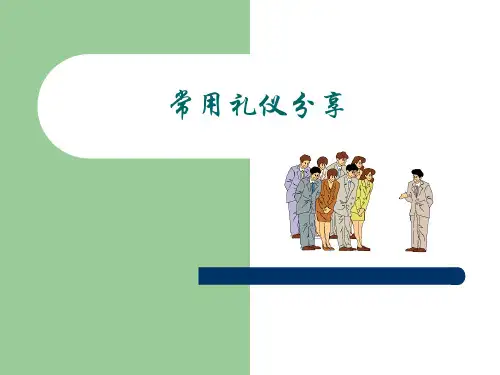
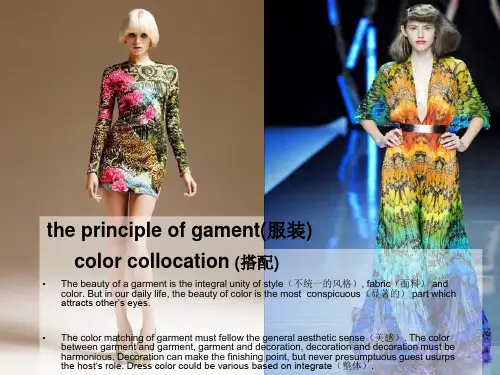
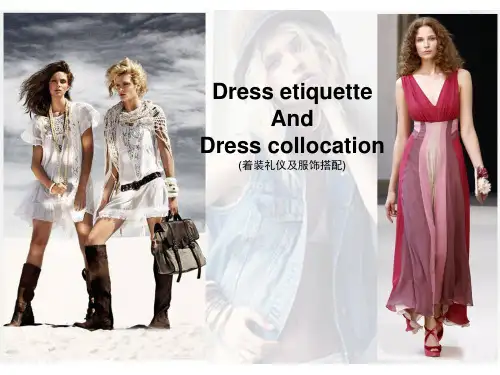
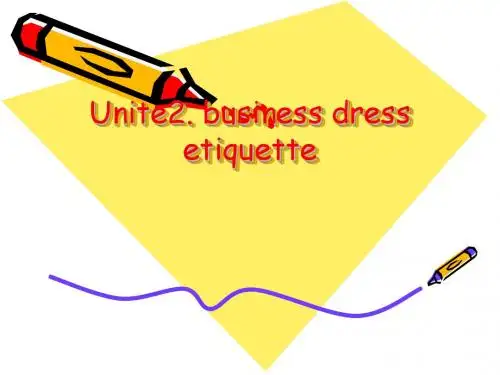
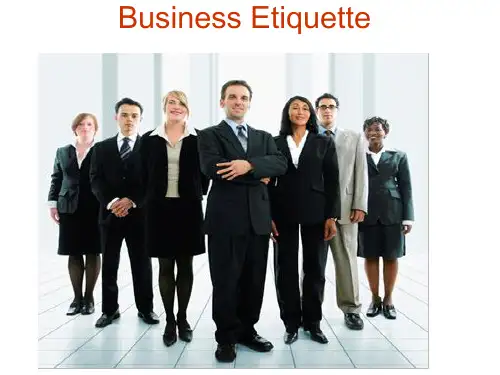
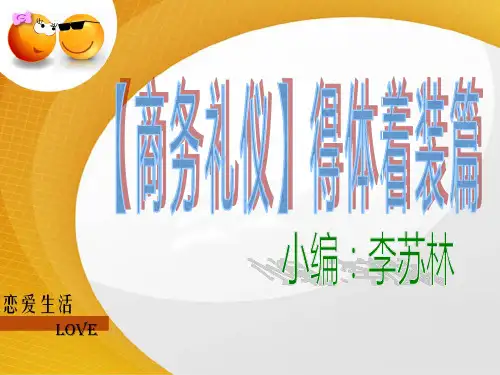

Business Attire & EtiquetteProduced by lonestar@JNUThis booklet is to teach you how to dress appropriately and proper etiquette for meals, etc.What is Business CasualThis page will explain what business casual is for men and women.Executive Wardrobe TipsThese tips will help you look like an executive for interviews and other events.Business Attire Do's & Don'tsThese dos & don'ts will help to keep you from making a mistake for interviews, informational meetings, career fairs, etc.Guidelines for Attire at Receptions, Presentations and Information Sessions Simple guidelines to help you figure out what is appropriate and what isn't.Telephone Etiquette 101Simple telephone etiquette to help you dazzle those recruiters over the phone.Dinner EtiquetteThis page not only gives you information on which fork to use, but also comes packed with images so you can picture what is written.Rules for Business DiningThese tips will hopefully help you land that ideal job, or big contract, with a few small maneuvers at lunch.What is Business Casual•Khaki pants, neatly pressed, and a pressed long-sleeved, buttoned solid color shirt are safe for both men and women. Polo shirts, unwrinkled, are an appropriate choice if you know theenvironment will be quite casual, outdoors or in a very hot location. This may not seem liketerribly exciting attire, but remember, you are not trying to stand out for the cutting edge look, but for your good judgment in a business environment.•Shoes/Belt: Leather belt and leather shoes (please, no athletic shoes at receptions).•Cost/Quality: You are not expected to be able to afford the same clothing as a CEO. However, do invest in quality that will look appropriate during your first two or three years on the job fora business casual environment or occasions.•Details: Everything should be clean, well-pressed, and not show wear. Even the nicest khakis after 100 washings may not be your best choice for a reception. Carefully inspect new clothes for tags, and all clothes for loose threads, etc. (as with interview attire).•Use common sense. If there is 10 inches of snow on the ground and you are rushing to an information session right after class and you left home 12 hours earlier, no one will expect you to show up looking ready for a photo shoot---they’ll just be happy you made it. If you show up at an event and realize you are not as well dressed as you should be, make a quick, pleasant apology, then make a good impression with your interpersonal skills and intelligent questions.• A briefcase or portfolio is not usually necessary for most business casual receptions or events.Specifics For Men's Business Casual•Ties: Ties are generally not necessary for business casual, but if you are in doubt, you can weara tie. It never hurts to slightly overdress. By dressing nicely, you are paying your host acompliment. You can always wear the tie and discreetly walk by the room where the function is held; if no one else is wearing a tie, you can discreetly remove yours if you have a place for it such as a jacket pocket.•Shirts: Long-sleeved shirts are considered dressier than short-sleeved and are appropriate even in summer. Choosing white or light blue solid, or conservative stripes is your safest bet.Polo shirts, (tucked in, of course), are acceptable in more casual situations.•Socks: Do wear dark socks, mid-calf length so no skin is visible when you sit down.•Shoes: Leather shoes should be worn. No sandals, athletic shoes or hiking boots.•Facial Hair: Just as with interviews: Facial hair, if worn, should be well groomed.•Jewelry: Wear a conservative watch. If you choose to wear other jewelry, be conservative.Removing earrings is always a safe bet.Specifics For Women's Business Casual•Pants/Skirts: Women can wear casual pants or skirts. Neither should be tight. For the most business-like appearance, pants should be creased and tailored; neither extremely tight orflowing. If you are in doubt about the industry “standard”, observe women in the industry on the job, at career fairs, at information sessions, etc.•Skirt Lengths: Often vary from season to season. Avoid extreme trends, especially with short lengths and/or high slits. Before choosing a skirt to wear, sit down in it facing a mirror. Be critical and ask yourself if the image is a person who looks appropriate in a business environment.•Shirts/Sweaters: In addition to tailored shirts or blouses, tailored knit sweaters and sweater sets are appropriate business casual choices for women.•Jewelry/Accessories: Wear a conservative watch. Jewelry and scarf styles come and go. Keep your choices simple and conservative. Avoid extremes of style and color.•Cosmetics: Avoid extremes of nail length and polish color, especially in conservative industries.•Shoes: Shoes should be leather or micro-fiber. Regardless of style, avoid extremes. Make certain you can walk comfortably in your shoes.•Hose: Hose are not essential for business casual, but are recommended with shorter skirts and in more formal environments. Trouser socks or knee-high hose are appropriate with slacks.•Purse/Bag: A tailored purse is best and one that hangs on your shoulder is often advantageous as it frees your hands for greetings (hand shakes) or holding a beverage. Often, leaving your purse locked in the trunk is preferable if you are uncertain what to do with it.Executive Wardrobe TipsMenSuits: Look for…•Classic fabrics, patterns, and colors which are always in style and easy to accessorize.•Contoured jacket collar that lays smoothly around the neck with no space between it and your shirt.•Smooth, straight seams with a single row of stitching.Suit care: Be sure to…•Hang suits on wooden or plastic contour hangers. Leave your jacket unbuttoned and be sure to empty pockets.•Leave space between hangers so garments will be free of wrinkles.•Read and follow the care instructions on your garment.Shirts: The best ones have…• A single row of stitching along shoulder and side seams to prevent puckering.•More stitches per inch. A quality shirt will have 15-18 stitches per inch for strength and better appearance.•Store ties unknotted to hang out wrinkles.Outer coats: Keep in mind that…•Outer coat sleeve length should cover the suit coat sleeve.•You should sit in your outer coat in the store to be certain that it is comfortable. Shoes:•Wear shoes that coordinate with your suit.•Keep shoes in good condition and polished.WomenSuits/dresses: Look for…•Classic fabrics, patterns, and colors which are always in style and easy to accessorize.•Dresses in solid color or conservative print.•Contoured jacket collar that lays smoothly around the neck with no space between it and your shirt.•Smooth, straight seams and hems.Suit care: Be sure to…•Hang suits on wooden or plastic contour hangers. Leave your jacket unbuttoned and be sure to empty pockets.•Leave space between hangers so garments will be free of wrinkles.•Read and follow the care instructions on your garment.Blouses/shirts:•Tailored blouses/shirts, not a lot of frills or ruffles.•Solid color or conservative prints to coordinate with suit.Shoes:•Wear low heeled pumps that coordinate with your suit/dress.•Keep shoes clean and in good conditionBusiness Attire Do's & Don'tsLooking the part promises both personal and financial success. Quality garments wear longer, fit better, and therefore, save money in the long run. Above all, if your clothing projects a professional image, others will respond to you in kind. Here are a few suggestions for maintaining the proper image:Men•Do wear your suit jacket when you conduct business outside your office.Your authority travels with you.•Do keep hair and nails clean and neat. •Do wear appropriate jewelry.•Do Not overpower your appearance with heavy cologne!•Do Not wear short-sleeved shirts under suit coats. Showing a clean cuff isa must.•Do Not wear ankle socks or light colored socks with a dark suit.Women•Do wear comfortable shoes and hosiery to complement your outfit.•Do wear natural looking makeup. •Do wear appropriate jewelry (no bangles or dangly earrings).•Do keep hair and nails clean and neat. •Do Not overpower your appearance with heavy perfume!•Do Not wear elaborate hairstyles. •Do Not wear jeans or casual slacks. •Do Not wear trendy fashions with built-in obsolescence.Guidelines for Attire at Receptions, Presentations and Information SessionsRemember! Regardless of the attire, you should want to present yourself in the most conservative and professional manner.Business DressBoth Men and Women: Should always wear a suit. Consider dark navy and gray. Men should wear shirts that are nicely starched and not taken right out of the dryer. White shirts should be white, not yellowish. Men’s ties should be seen and not heard.Women: Should avoid wearing several pieces of jewelry, especially dangling, chunky sorts. Wear clothing accessories and jewelry that make you look polished and professional. Make sure skirts are at least knee length. Women should always wear hose, and shoes with heels. You should try to be on the conservative side rather than trying to look glamorous.Nice or Business CasualMen: Should avoid Khaki pants and “loud print” shirts. Consider dark-colored slacks with a nice Oxford shirt with muted colors and a conservative matching tie. If the weather is cold, pull on a nice solid color sweater. Another option is wearing dark slacks, solid or bold line shirt, and a nice dark-colored sports coat or blazer. Belt and shoes should match.Women: Should consider wearing business skirts with appropriate blouses, such as silks, polyester, or rayon with attractive prints. Nice slacks with a blazer or pants suits are also acceptable. Larger pieces of jewelry are acceptable for nice casual. Flats or small heels are appropriate, and of course, always wear hose.CasualMen: It is acceptable for men to wear nice khaki, navy or some other basic color slacks. Polo type shirts, “Camp” shirts or collared shirts long- or short-sleeved would be appropriate. Stay away from blue jeans, denim, and sweat suit material. Shirts should be crisp and colorful but not “neon-looking!” No cut-off or jean shorts.Women: Appropriate attire for women might be a skirt and blouse, or tailored slacks, blouse, and nice belt, attractive coordinated, flats, and always hose. No cut-off or jean shorts.Telephone Etiquette 101For most of us, the telephone is a vital source of communication. The use of cell phones and “instant conversation” is commonplace in our life today. However, when applying for an internship or permanent position, the way you conduct yourself on the phone may be a key factor in a future employer’s decision to hire you on a permanent basis.These tips will show you how paying attention to detail may make a big difference in others impressions of you....both personally and professionally.Identify Yourself•When calling someone , do you identify yourself after they've said hello?Respect Others' Time•When Placing a call, after identifying yourself, do you ask "Do you have a Minute?" or "Is this a good time to reach your?" before explaining the reason for your call?Ask Rather Than Just Place Someone On Hold•After placing someone on hold and returning to the line, say "Thanks for waiting" rather than "I'm back."•When screening calls, do you ask "Who's calling, please?" rather than "Who is this?"When calling a professional office for any reason, always identify yourself and explain the reason for your call. Example: “ Hello, this is Tom Cruise and I’m calling in response to the newspaper ad for an actor”.Call WaitingCall waiting is only as good as the person using it. Rule #1: Just because you have call waiting, it is up to you whether to use it…it is a judgment call. Your decision should be based on who you are speaking to, the intensity of the conversation, and your relationship to the person. If you find it necessary to place someone on hold -- Due to call waiting -- Always ask permission!Answering/Voice Mail MachinesWhen reaching an answering machine, if you had sufficient reason for calling…leave a message. Sometimes this helps the other person know how to respond…whether to expect another call from you or if they should attempt to return your call. “Hi, its Julie, Bye!” doesn’t say anything, does it? When leaving a message, “what” and “how” you say it is as important as if you were speaking to the person directly. Keep the tone of your voice pleasant and upbeat!Use Good Speech HabitsPhrases To use: “ One moment please”, “Yes”, “All right”, “She’s not available now”, “Good-bye” Phrases Not To Use: “Hang on”, “Yeah”, “Okey-Doke”, “Uh, dunno where he is”.Remember: You only get ONE chance to make a first impression!Dinner EtiquettePositioning of a Place Setting for Dinner•Place Plate-The place plate is placed one inch from the edge of the table. If the first course is already on the place plate, the napkin is placed to the left of the forks, otherwise the napkin will be on the plate.•Forks/Flatware-Handles of the flatware are aligned at the bottom. The forks (no more than three) are at the left of the place plate, placed in order of use, working from theoutside in. The oyster fork is the only fork on the right side with the knives, tines of the fork placed upward, across the soup spoon or parallel with the knives.•Often in North America the salad is served prior to the main course. In this case, the salad fork is positioned the furthest from the plate on the left. One would use this fork first. In the case of French style dining, the salad would be served after the maincourse. In this case, the salad fork would be positioned next to the plate.•Knives-Knives, no more than three, are at the right of the place plate in order of use, from the outside in, with the cutting edge toward the plate. The only spoon (for a first course) is placed to the right of the knives.•Dessert Silverware-The dessert fork and spoon are above the place plate, the bowl of the spoon facing left, the fork below facing right. In the most formal setting, the dessert fork and spoon are brought in on the dessert plate.•Glassware-No more than four glasses are set on the table, in order of use, for water, white wine, red wine and champagne, from the left to the right.•Full Glasses-When filling glasses, note the above diagram. Don't overfill!•Stemware-Note the shapes of each type of stemware. They all have a unique shape and should only be used for their respective drinks.•Bread and Butter Dish-The butter plate (optional) has the knife placed across the top of the plate, handle to the right, edge of blade toward the user. The salt and pepper are above the place plate, pepper to the left of salt. Larger salts and peppers to be shared are placed slightly below the wine glasses and between every two place settings.•At the end of the meal, you should place your used silverware close together on the plate, with the utensils entirely on the plate (less than an inch of the silverware over the side of the plate). This is a signal to the servers that your meal is finished and the dishes can be removed.•For a formal dessert service, a waiter brings each guest a finger bowl filled with water. The bowl is set on a small lace or organdy doily (optional), which in turn sits on the dessert plate. The dessert fork and spoon are balanced on the plate in this case (instead of sitting at the top of the place setting throughout the meal.) A guest should dip finger tips in the finger bowl, wipe them on his or her napkin, and then remove the finger bowl and doily to the upper left of the place setting. He or she now moves the fork and spoon from the plate to the left and right of the plate respectively. The empty plate is now readyto receive a helping of dessert.Proper Eating Style•The correct way to cut your meat, whether eating American or continental style, is to grasp your knife and fork in a relaxed, natural manner, never with clenched fists.•In the American style of eating, after cutting your meat, you switch the fork to your right hand, place your fork on the plate, spear a piece of meat, and then eat it.•In the Continental eating style, you keep your fork in your left hand and convey the food to your mouth after cutting each piece. The knife remains in your hand and may be subtly used to get meat or any other food.Rules for Business Dining"It may look like lunch, but it's still business!"•When inviting a client to lunch, remember that the restaurant you select is subconsciously perceived as an extension of your office. Therefore, select a restaurant where the food is of good quality and the service is reliable.•When escorted to a table by a maitre'd, allow your guest(s) to walk behind the person.When finding a table on your own, take the lead.•Be sure to extend the "power" seat to your client. Seat yourself in the seat with your back facing the door/main body of the room.•Once everyone is seated, place your napkin on your lap. This gesture serves as a cue that the meal is about to begin.•When making a food recommendation, recognize that most guests also take your suggestion as the price range to stay within.•When the server asks for your meal order before your guests', it's the perfect time to say, "I'd like my guest(s) to order first." Besides being appropriate, it's a cue to let the server know that the check should be left with you at the end of the meal.•When reaching for the bread basket, salad dressing, etc., offer them to your guest(s) BEFORE using them yourself.•Finally, tip adequately. Treat the server as one of your employees. It's a small price to pay for good service, personal attention and, hopefully, the contract that you land!.。